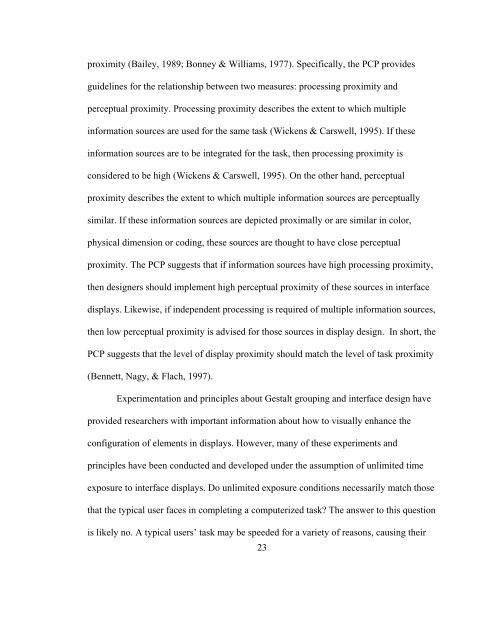The Use of Iambic Pentameter in the
The Use of Iambic Pentameter in the
The Use of Iambic Pentameter in the
Create successful ePaper yourself
Turn your PDF publications into a flip-book with our unique Google optimized e-Paper software.
proximity (Bailey, 1989; Bonney & Williams, 1977). Specifically, <strong>the</strong> PCP provides<br />
guidel<strong>in</strong>es for <strong>the</strong> relationship between two measures: process<strong>in</strong>g proximity and<br />
perceptual proximity. Process<strong>in</strong>g proximity describes <strong>the</strong> extent to which multiple<br />
<strong>in</strong>formation sources are used for <strong>the</strong> same task (Wickens & Carswell, 1995). If <strong>the</strong>se<br />
<strong>in</strong>formation sources are to be <strong>in</strong>tegrated for <strong>the</strong> task, <strong>the</strong>n process<strong>in</strong>g proximity is<br />
considered to be high (Wickens & Carswell, 1995). On <strong>the</strong> o<strong>the</strong>r hand, perceptual<br />
proximity describes <strong>the</strong> extent to which multiple <strong>in</strong>formation sources are perceptually<br />
similar. If <strong>the</strong>se <strong>in</strong>formation sources are depicted proximally or are similar <strong>in</strong> color,<br />
physical dimension or cod<strong>in</strong>g, <strong>the</strong>se sources are thought to have close perceptual<br />
proximity. <strong>The</strong> PCP suggests that if <strong>in</strong>formation sources have high process<strong>in</strong>g proximity,<br />
<strong>the</strong>n designers should implement high perceptual proximity <strong>of</strong> <strong>the</strong>se sources <strong>in</strong> <strong>in</strong>terface<br />
displays. Likewise, if <strong>in</strong>dependent process<strong>in</strong>g is required <strong>of</strong> multiple <strong>in</strong>formation sources,<br />
<strong>the</strong>n low perceptual proximity is advised for those sources <strong>in</strong> display design. In short, <strong>the</strong><br />
PCP suggests that <strong>the</strong> level <strong>of</strong> display proximity should match <strong>the</strong> level <strong>of</strong> task proximity<br />
(Bennett, Nagy, & Flach, 1997).<br />
Experimentation and pr<strong>in</strong>ciples about Gestalt group<strong>in</strong>g and <strong>in</strong>terface design have<br />
provided researchers with important <strong>in</strong>formation about how to visually enhance <strong>the</strong><br />
configuration <strong>of</strong> elements <strong>in</strong> displays. However, many <strong>of</strong> <strong>the</strong>se experiments and<br />
pr<strong>in</strong>ciples have been conducted and developed under <strong>the</strong> assumption <strong>of</strong> unlimited time<br />
exposure to <strong>in</strong>terface displays. Do unlimited exposure conditions necessarily match those<br />
that <strong>the</strong> typical user faces <strong>in</strong> complet<strong>in</strong>g a computerized task? <strong>The</strong> answer to this question<br />
is likely no. A typical users’ task may be speeded for a variety <strong>of</strong> reasons, caus<strong>in</strong>g <strong>the</strong>ir<br />
23

















